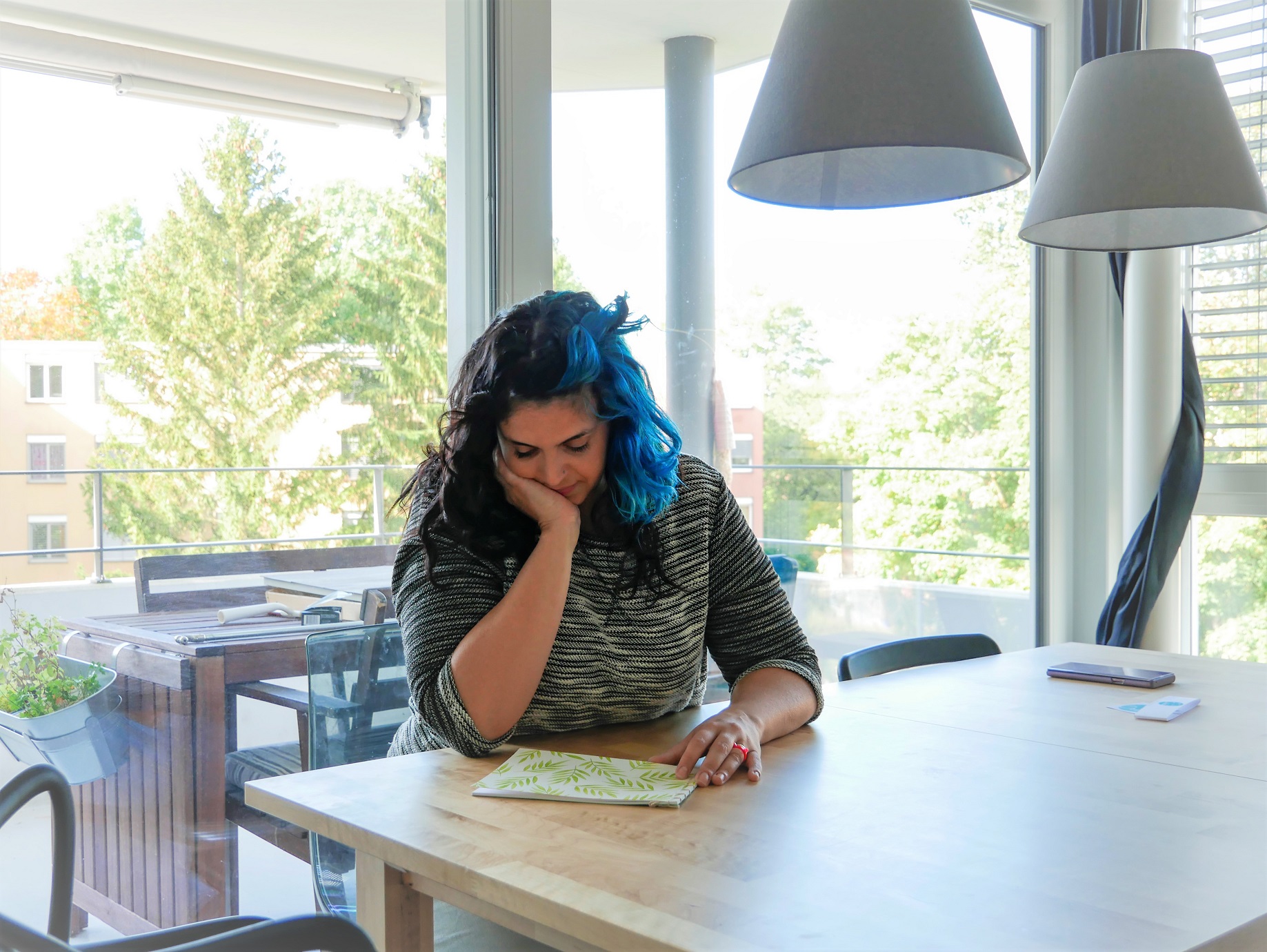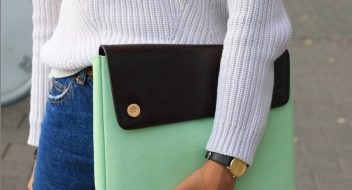In this interview, Kaspar Schmocker explains how to create demand for a brand new product,…
Barbara Brandimarte
About paper jewelry, inspiration from nature and the difference in mentality

How can you radically change your profession? Why is freedom more valuable than stability? What inspires artists and how do they deal with creative crises?
Barbara Brandimarte is the creator of the paper jewelry brand Colla Carta Creo. She studied something quite different, but after completing a master’s degree and working in several companies, she decided that office jobs did not suit her. Her own wedding inspired her to start a creative project, and since then she has been turning ordinary paper into works of art. In this interview, Barbara tells us how ideas emerge from chaos, how perfectionism was preventing her from starting the project, how she moved her business venture from Italy to Switzerland, and why an artist’s eccentricity must be combined with perseverance.

Barbara, how did you start a career as a designer? Where did you learn that?
In fact, I studied design on my own. I am an architect by profession, but I pretty quickly decided that I didn’t want to work in this field. The fact is, in Italy the career path of an architect is long and challenging. After graduating from university, you have to work as an intern for several years, often without a contract or salary. And even after that it is very difficult to get a good job, not to mention opening a private studio. You have to compromise all the time, agree on doing work you don’t like. This greatly reduces motivation and enthusiasm. At some point it became clear to me that I don’t want to be an architect under such conditions.
Have you always dreamed of creating your own project or have you been urged to do so by any life events?
I think it came with time and experience. When I was working in a studio, I realized that it was very difficult for me to be locked up in the same room every day and only do what I was told. Of course I can work like that, but that doesn’t make me happy. Now I appreciate freedom very much. Yes, being an independent artist is not easy. It is especially difficult to start and develop your brand, to make it desirable, high quality and memorable as well as to overcome your creative crises. But for me it is much more enjoyable than being an employee of a company and following the instructions of others.
Many people think that paper is too fragile and in some ways disposable. But in fact, you can make so many things out of it.
How did you find your new vocation?
It all started with the preparation of my wedding. I decided to make invitations and bonbonnieres for the guests myself, and it was very exciting. I loved this creative process so much that I thought why not turn creativity into a profession? I received my first orders exactly for the creation of invitations and decor for weddings and other events. Then I started designing postcards and notebooks. In the course of my work I began to develop new ideas. I thought about what else I could do with paper and came up with the idea of jewelry.
Paper jewelry is a very unusual solution. Why did you choose this particular direction?
I like paper as a material – to work with it, to create something completely new. Many people think that paper is too fragile and in some ways disposable. But in fact, you can make so many things out of it. I wanted to show that paper can be completely different – durable, stable. It can be a decorative element or a beautiful accessory.
Photo: @collacartacreo
Was it your own idea or had you seen something similar somewhere?
No, the idea is not mine. The technique of making paper jewelry has existed for a long time, I saw examples of such works at some point and became interested. Then I found a teacher for quilling in Piacenza, the designer Angela Simone, and was trained by her. Quilling appeared on the European Mediterranean coast in the XIV century. It consists of a twisting of numerous strips of paper and their subsequent connection to complex compositions – paintings, furnishings, jewelry. This process requires not only creativity, but also perseverance and really delicate work.
Is that how you make your jewelry?
Yes, some of it, for example, necklaces. I take paper in different colors and widths, wrap lots of stripes and connect them to compositions. The earrings are made using a different technique: I cut and glue dozens of layers, press them together, polish them and finally apply my pattern to the surface. In addition, I process all the jewelry with a special solution that protects it from deformation under wet conditions.
Does this mean that paper jewelry can be very durable?
Yes, at medium humidity they retain their shape and appearance perfectly, so you don’t have to worry. But of course they are still a decorative accessory. So you shouldn’t shower or walk in the pouring rain in them.
You said you draw your own musters on the jewelry. Does that mean that each piece is unique in the end?
Most of my jewelry is unique, yes. Colors and patterns can be repeated in collections, but they won’t be exactly the same because I draw by hand. In a few exceptions, I create designs in a graphic editor and print them out, then the image can be repeated. But in such cases I try to make different shapes and sizes, so that each piece of jewelry is unique.
Handiwork, multiple layers, hand-painted drawings – that sounds like a lot of work. How much time does it take you to make one piece of jewelry?
On average one or two days. It’s not just about the complexity of the production, it’s also about the specifics of the technology. After all the elements have been prepared and glued, it takes a few hours to dry them. The waterproof coating also needs time for fixation. But I can make several pieces of jewelry in parallel in one day.
My collections depend on mood and inspiration.
How do you come up with ideas and designs for new jewelry?
My collections depend on mood and inspiration. I can wake up and think I want to try a combination of yellow and blue today – and I’m starting to work out the options. Later I may like the ornament, but I would like to try it in other colors. So I experiment, try, seek inspiration every day.
Where do you get inspiration for your work?
The most important sources of inspiration for me are nature and geometric shapes. On weekends I like to hike in the mountains or walk around. I pay attention to colors, patterns and shapes. I can watch the blossoming flower or the reflection of clouds in the lake for a long time. I also love taking photos – it’s my passion. My reflex camera is always with me and I can work on a shot for 2 hours because I want it to be absolutely perfect. I know it will be my source of inspiration afterwards, which is why I work so hard on it.
Photo: @collacartacreo
Let’s go back to the beginning. When exactly did you start this project and when did you win your first customers?
I’ve been making paper jewelry since 2014, but I didn’t start selling it right away. It took me about 6 months to get a result that I would be satisfied with. The first few collections I threw away right after the creation. I wanted everything to be perfect: shape, design, colors. I was able to achieve this by 2015, and then I launched my first collection for sale. In the course of time the ideas and inspirations developed and new collections were born.
Are you satisfied with the quality of your jewelry today?
I only market the pieces that I like. But there are still many patterns and ideas that I test and then throw away. This happens with both prints and designs. Moreover, sometimes when I review my work after a while, I may become disappointed.
Serious support for me is customer feedback.
How do you cope with such disappointments?
Serious support for me is customer feedback. Many people send in comments or personal messages saying that they like my work. This is very valuable. Besides, my husband is very helpful, he believes in me and supports me in everything. For example, when I take part in trade fairs, he works with me on the stand and helps me in every possible way.
Speaking of fairs, this is one of your most important promotional formats, isn’t it?
Yes, I started taking part in fairs when I lived in Italy; I regularly went to Rome, Milan and other cities where handicraft fairs were held. I think it is important that people can see, touch and feel my jewellery. In Switzerland I have already exhibited in Frau Gerold’s Garden, Markthalle and at several Christmas markets.
And how do you find these fairs, how do you choose which ones to attend?
On social media I follow other artists and see which events they visit. This is how I find out which fairs and events are popular. And when considering participation, I pay attention to the costs of rent and traffic. It is important for me to at least go to zero, so I calculate the approximate result. It doesn’t always meet expectations. But in general, I understand that in order to make money, you have to invest first. You have to take a certain risk without which development is not possible.

What other advertising channels do you invest in and how successful are they for you?
Of course, I also promote the project via online channels. First of all, I run pages on social networks – Facebook, Instagram, Pinterest. To tell you the truth, it is not always easy for me, because you must understand the methods of advertising and promotion on each of these platforms. Since I do everything myself, I need a lot of time and effort to do it, so in the long run I want to find someone to help me with these tasks. Another important online platform for me is Etsy, where my online shop and all the current collections are presented.
The third important sales channel for me are retail shops. Now my jewelry is available in a shop in St. Gallen. I am also negotiating with the shops in Zurich and Basel. Of course, stores charge a certain percentage of the revenue, but your product becomes visible to customers and more people can learn more about it.
In Italy I was often told: “Oh, it’s made of paper, then it has to be cheap, so give me a discount.”
You started the project in Italy, and now you have been operating it in Switzerland for over a year. Do you see the difference between these markets?
Yes, the difference is huge. First, in the mentality and its manifestations at purchase. In Switzerland, for example, people understand the value of handmade goods and if they like jewelry, they buy it without negotiation. In Italy I was often told: “Oh, it’s made of paper, then it has to be cheap, so give me a discount.” In such cases, I always explain that it’s not about the cost of the material, but about the effort and uniqueness of the product. In Switzerland this is beyond question, in Italy it is more challenging.
On the other hand, you are at home in Italy, and here you are an expat. Are there any difficulties with integration?
Well, I do not speak German, and that certainly makes work a little more difficult. However, there are many Italian-speaking people here, I meet many of them at every fair. Plus in Zurich and other big cities there is no problem with English either, so I don’t have too many difficulties.
Photo: @collacartacreo
How would you describe yourself as a person?
I am moody. Eccentric. Creative. A bit weird. I say that because watching me at work may seem crazy. I can work and concentrate for long periods and then suddenly get angry at the last moment because I am not satisfied with the result. Then the materials literally start to fly across the room. My husband jokingly says that it’s time to create an Instagram account “Artist at Work” because it looks really funny from outside.
What helps you to recharge your batteries and cheer up in such creative crises?
Travelling, walking and eating. I like hiking in the mountains, snowboarding and travelling to non-tourist places. I especially like to get to know the cuisine of other countries and try something new.
Besides, I have two hobbies that I love very much but have not yet been able to implement in Switzerland. I have been playing volleyball for a long time and am now looking for a team to join in Zurich. Secondly, I volunteer for the ambulance in Italy and I’m still doing it there. I would love to find something like this in Switzerland, but for that my German is not good enough yet.

How would you like to develop your project in the next 5-10 years?
I would like to work exclusively on my creative projects. Now, parallel to jewelry production, I am working on a regular job to be able to invest more in brand development. Secondly, I would like to focus on one kind of product that will make my brand distinctive and recognizable.
We hope you achieve all these goals! To finish, what advice could you give to beginner artists?
Don’t be afraid to change your lifestyle completely – quit your job, change your profession, start something new. If you are not satisfied with your life, change it as soon as possible. If you have a dream or an idea, do it at any price. Try it, make a mistake, try again. This is the way we all go. And that is what leads us to the brightest adventures of our lives.
Thank you very much for this interesting conversation and useful tips! We wish you all the success with your projects!
Contacts:
Learn more about Colla Carta Creo
Website: http://www.collacartacreo.com/
Etsy: https://www.etsy.com/it/shop/CollaCartaCreo
Instagaram: https://www.instagram.com/collacartacreo/
Facebook: https://www.facebook.com/CollaCartaCreo/
Pinterest: https://www.pinterest.it/bbrandimarte81/






















This is post Can I contact you? Can I write to you directly. It’s so good that i’m going follow you!
Sure! You can contact us per email info@demobytes.xyz